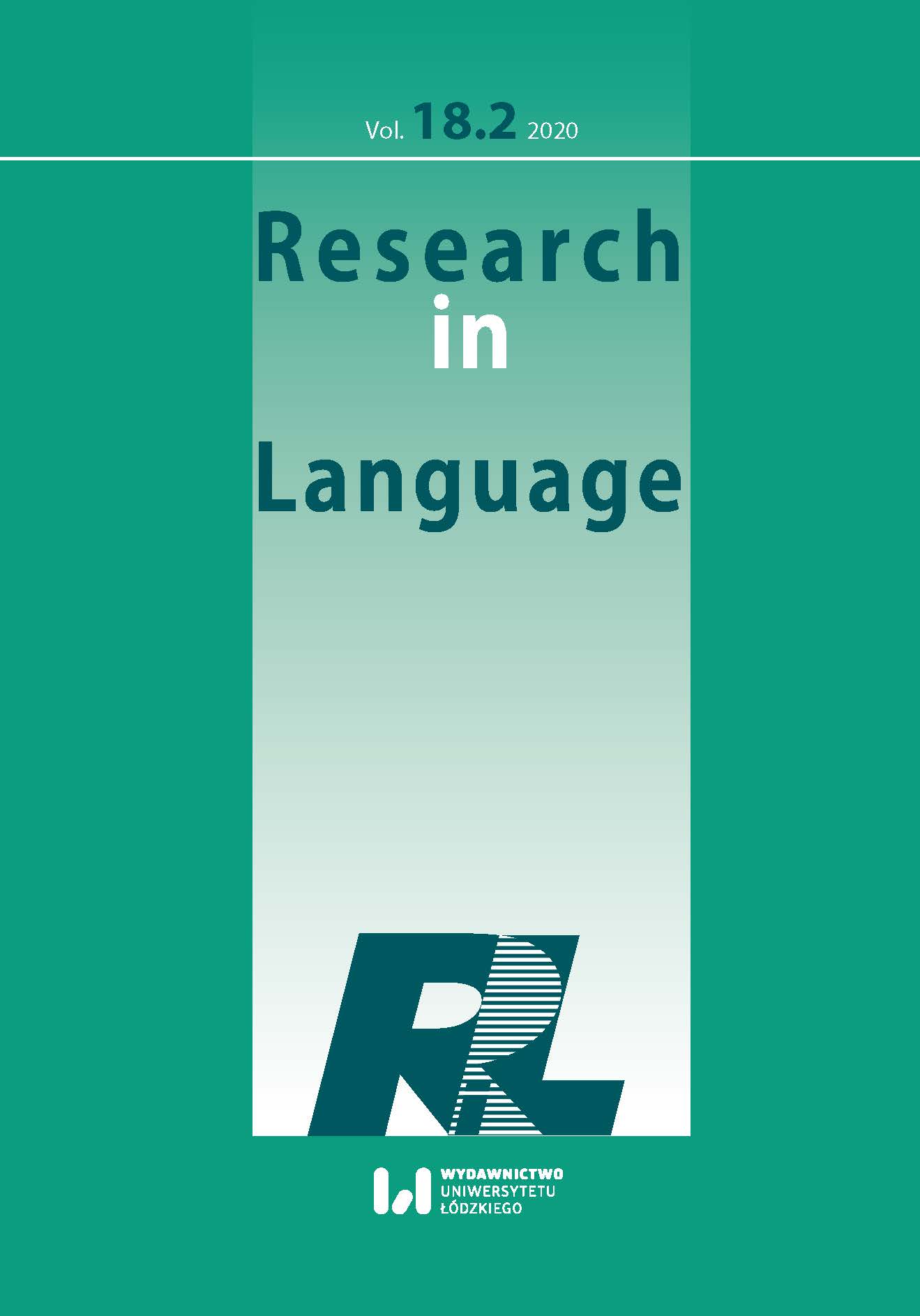Cohesion in Polish-English Translation and Its Implications for Translator Training
DOI:
https://doi.org/10.18778/1731-7533.18.2.06Keywords:
translator training, contrastive grammar, Polish-English translation, cohesion in translation, word orderAbstract
This paper focuses on the ways of maintaining cohesive links in the translation process in the Polish-English language pair. Of primary interest is how the thematic/rhematic structure of Polish sentences can be successfully rendered in English to produce cohesive, natural-sounding and communicative target texts with a proper information flow. These aspects have implications for translation teaching. It has been observed that, in view of the differences between Polish and English word order, university students at the start of their translator training experience two general problems as they attempt to translate longer stretches of text into English: (1) they produce cohesive passages, which contain errors in word order (due to syntactic interference from Polish) or (2) they produce grammatically correct sentences, which, however, form incohesive passages (i.e. ones in which the thematic/rhematic progression is not retained) with an inappropriate information structure. For this reason, students need to become acquainted with some practical solutions that help build cohesion in Polish-English translation. These include (1) shifts from active to passive, (2) other shifts in syntactic functions, (3) fronting, and (4) inventing sentence subjects out of broader context.
References
Baker, Mona. 1992. In other words (A coursebook on translation). London/New York, Routledge. https://doi.org/10.4324/9780203133590
Google Scholar
DOI: https://doi.org/10.4324/9780203133590
Belczyk, Arkadiusz. 2002. Poradnik tłumacza: z angielskiego na nasze. Kraków: Idea.
Google Scholar
Biber, Douglas, Johansson Stig, Leech Geoffrey, Conrad Susan and Finegan Eward. 1999. The Longman Grammar of Spoken and Written English. London, Longman.
Google Scholar
Blum-Kulka, Shoshana 1986. Shifts of cohesion and coherence in translation. In J. House and S. Blum-Kulka (eds.), Interlingual and Intercultural Communication: Discourseand Cognition in Translation and Second Language Acquisition Studies, 17-36. Tübingen: Gunter Narr.
Google Scholar
Chesterman, Andrew. 2004. Hypotheses about translation universals. In G. Hansen, K. Malmkjær and D. Gile (eds.), Claims, Changes and Challenges in Translation Studies: Selected contributions from the EST Congress, Copenhagen 2001, 1-13. Amsterdam/Philadelphia: John Benjamins Publishing Company. https://doi.org/10.1075/btl.50.02che
Google Scholar
DOI: https://doi.org/10.1075/btl.50.02che
Duszak, Anna. 1987. The dynamics of topics in English and Polish. Warszawa: Wydawnictwa Uniwersytetu Warszawskiego.
Google Scholar
Fisiak, Jacek, Lipińska-Grzegorek Maria, and Zabrocki Tadeusz. 1978. An introductory English-Polish contrastive grammar. Warszawa: Państwowe Wydawnictwo Naukowe.
Google Scholar
Górnicz, Mariusz. (2014) Hipertematy a szyk zdania w polskich tekstach specjalistycznych. In M. Kornacka (ed.), Spójność tekstu specjalistycznego, 21-29. Warszawa: Wydawnictwo Naukowe Instytutu Kulturologii i Lingwistyki Antropocentrycznej Uniwersytet Warszawski.
Google Scholar
Halliday, Michael A. K. 1985. An introduction to functional grammar, London: Edward Amold.
Google Scholar
Halliday, Michael A. K. and Hasan Ruqaiya. 1976. Cohesion in English. London: Longman.
Google Scholar
Hatim, Basil. 2003. Text linguistics and translation. In M. Baker (ed.), Routledge Encyclopedia of Translation Studies, 262-265. New York: Routledge.
Google Scholar
Hu, Helen Chau. 1999. Cohesion and coherence in translation theory and pedagogy, Word, 50(1), 33-46. https://doi.org/10.1080/00437956.1999.11432482
Google Scholar
DOI: https://doi.org/10.1080/00437956.1999.11432482
Kaczmarek, Karolina. 2014. Interpretacja terminologii związanej z teorią tekstu w aspekcie spójności (aspekt synchroniczny i diachroniczny w kształtowaniu się znaczeń na przykładzie terminów kohezja i koherencja)”. In M. Kornacka (ed.), Spójność tekstu specjalistycznego, 30-39. Warszawa: Wydawnictwo Naukowe Instytutu Kulturologii i Lingwistyki Antropocentrycznej Uniwersytet Warszawski.
Google Scholar
Kerremans, Koen. 2017. Applying computer-assistedcoreferential analysis to a study ofterminological variation in multilingualparallel corpora. In K. Menzel, E. Lapshinova-Koltunski, and K. Kerstin (eds.), New perspectives on cohesion and coherence: Implications for translation, 49-74. Berlin: Language Science Press.
Google Scholar
Kunilovskaya, Maria and Kutuzov Andrey. 2017. Testing target text fluency: A machine learning approach to detecting syntactic translationese in English-Russian translation. In K. Menzel, E. Lapshinova-Koltunski and K. Kerstin (eds.), New perspectives on cohesion and coherence: Implications for translation,75-103. Berlin: Language Science Press. https://doi.org/10.1515/9783110459586-010
Google Scholar
DOI: https://doi.org/10.1515/9783110459586-010
Lautimatti, Liisa. 1987. Observations on the development of the topic of simplified discourse. In U. Connor and R. B. Kaplan (eds.), Writing across languages: Analysis of L2 text, 87-114. Reading: Addison-Wesley.
Google Scholar
Majchrzak, Konrad. 1978. The structure of the noun phrase in English and Polish: a contrastive analysis (unpublished PhD dissertation), Poznań.
Google Scholar
Menzel, Katrin, Lapshinova-Koltunski Ekaterina and Kerstin Kunz. 2017. Cohesion and coherence in multilingual contexts. In K. Menzel, E. Lapshinova-Koltunski and K. Kerstin (eds.), New perspectives on cohesion and coherence: Implications for translation, 1-10. Berlin: Language Science Press.
Google Scholar
Schäffner, Christina. 2000. Running before walking? Designing a translation program at undergraduate level. In C. Schäffner and B. Adab (eds.), Developing translation competence, 143-157. Amsterdam: John Benjamins Publishing Company. https://doi.org/10.1075/btl.38.14sch
Google Scholar
DOI: https://doi.org/10.1075/btl.38.14sch
Szwedek, Aleksander. 1981. Word order, sentence stress and reference in English and Polish. Bydgoszcz: Wydawnictwo Uczelniane WSP.
Google Scholar
Tanskanen, Sanna-Kaisa. 2006. Collaborating Towards Coherence: Lexical Cohesionin English Discourse. Amsterdam/Philadelphia: John Benjamins Publishing Company. https://doi.org/10.1075/pbns.146
Google Scholar
DOI: https://doi.org/10.1075/pbns.146
Williams, Joseph M. 1994. Style: Ten Lessons in Clarity and Grace. New York: HarperCollins.
Google Scholar
Willim, Ewa and Mańczak-Wohlfeld Elźbieta. 1997. A contrastive approach to problems with English.Warszawa/Kraków: Państwowe Wydawnictwo Naukowe.
Google Scholar
Downloads
Published
How to Cite
Issue
Section
License

This work is licensed under a Creative Commons Attribution-NonCommercial-NoDerivatives 4.0 International License.










